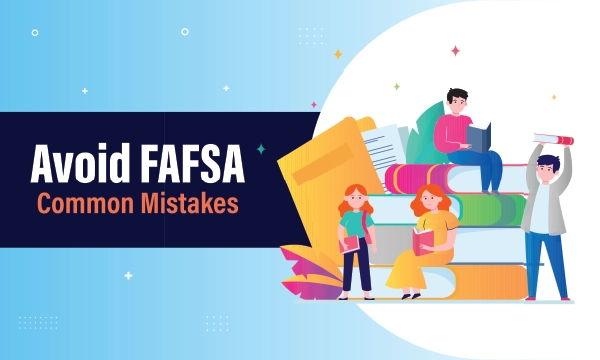7 FAFSA Mistakes Students Must Avoid
Table of Contents
FAFSA, or the Free Application for Federal Student Aid, is a form that opens the door to financial support in the US. It is how students access federal grants, scholarships, and work study courses. But here is the catch: one small mistake in the form can cost you thousands of dollars. Think of FAFSA as more than paperwork. It also helps you determine how much assistance you will receive.
This will help you determine how much assistance you will receive not only for essentials like books, transportation, and student housing in the USA. Every year, many students lose out on funding. Not because they weren’t eligible, but because they filled it out incorrectly or missed deadlines. In this guide, we will talk about the top FAFSA mistakes students must avoid. Let’s get started!
What are the Top FAFSA Mistakes students must avoid?
FAFSA does look straightforward on the surface. But it’s surprisingly easy to get things wrong. And the smallest mistakes cost students thousands of dollars. According to recent data, nearly 40% of applicants make at least one major error. This often results in delayed or reduced financial support. The following are the top FAFSA mistakes of students:
Missing FAFSA Deadlines
One of the top FAFSA mistakes is assuming that there is lot of time. Federal aid has a final deadline. But individual states and colleges often distribute funds on a first-come, first-served basis. Submitting even a few days late can mean losing access to scholarships completely. Early submission increases your chances of receiving full aid, especially if you plan to cover the rent of your student accommodation.
Providing Incorrect or Incomplete Financial Information
When you provide inaccurate tax or income details, this is one of the most damaging mistakes. Many students use outdated information which in turn leads to application verification or rejection. Using IRS Data Retrieval Tool (DRT) significantly reduces errors and ensures you don’t accidentally report incorrect income.
Confusing Parent vs. Student Income Details
One of the most common mistakes for students is to mix who earns what they do. Dependent students must separate their own earnings from their parent’s income. When this information overlaps or is misreported, it alters the Expected Family Contribution (EFC). And many times, it leads to low financial awards. That’s why it’s critical.
Leaving Blank Fields Instead of Writing ‘Zero’
One of the most overlooked Top FAFSA Mistakes is leaving certain fields empty. It might seem harmless, but to the system, a blank field doesn’t mean “not applicable”. It signals a potential error and FAFSA cannot assume your intention. If a specific expense or income doesn’t apply to you, it must be marked as “0”, not left empty. According to FAFSA processing data, incomplete forms are among the top reasons applications get delayed or flagged for verification.
Failing to List All Eligible Colleges on FAFSA
One of the common misconceptions is that FAFSA should only include the first-choice college. FAFSA allows you to list upto 20 schools. And every college you include gives you access to your aid eligibility. So, if you fail to list them, these colleges cannot build a financial package. And if you miss this step, you can limit your options.
Not Accounting for Housing and Accommodation Costs
This is one of the costliest mistakes you can make. FAFSA doesn’t just cover tuition. It uses your full cost of attendance, which includes student accommodation, food, transport, and personal needs. If you do not include housing costs, it will directly affect your aid calculation.
Conclusion
Filling out your FAFSA form is not just another college form. A single missed deadline or blank field can cost you your grant or scholarship. The students who receive the most aid aren’t always the ones with the highest need. They’re the ones who complete FAFSA carefully, correctly, and on time. By understanding these mistakes, you can protect your chance not only to tuition. You can also get rewards for daily essentials like books and student accommodation.
And when it comes to housing, don’t leave it to the last minute. University Living helps students find verified, budget-friendly student housing in the USA, so you can focus on your education. Apply smart. Live smarter. Your journey deserves both.
Frequently Asked Questions
What is the most common mistake made on the FAFSA?
One of the most common FAFSA mistakes is leaving fields blank or entering incomplete financial information. Students often skip sections, misreport income or forget to include untaxed income.
How can I get the most out of my FAFSA application?
To maximize aid, students should reduce their taxable income during the FAFSA base year. And they must avoid holding unnecessary assets in their name. Having multiple family members enrolled in college also increases their eligibility.
What can you count as unusual circumstances on FAFSA?
Unusual circumstances apply when a student cannot provide parental information. The reason is having issues like abuse, neglect, or abandonment. In these cases, the Financial Aid Office may classify the student as independent. This helps them to apply for aid without parental details.
What if I made a mistake on my FAFSA form?
If you notice an error after submitting FAFSA, you can log into your account and make corrections. Once updated, both the student and parent (if dependent) must re-sign the form to ensure the changes are processed.
How do I remove a contributor from FAFSA?
To remove a contributor, log in to StudentAid.gov. Open your FAFSA application, and navigate to the contributor section. Select “Manage Contributor Info”. Then confirm the changes. Make sure to save and re-sign the form to finalize the update.

